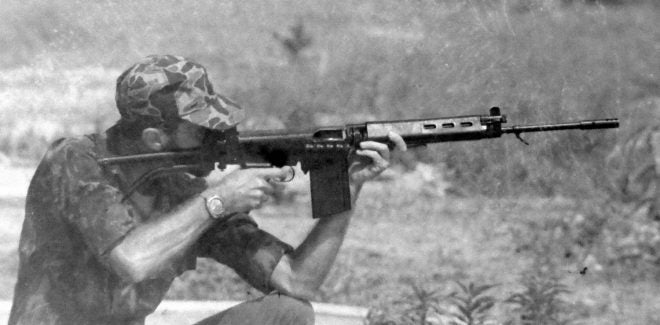The idea is far now new: have a smaller-caliber gun to replace the real one for initial training so that you can achieve substantial cost reductions in the process. Simple as that. The formula has met with varying degrees of success (or lack of) in different countries along the years, and was also tried – albeit briefly – in Brazil thirty or so years ago.
The Rossi EB-79/FAC

The 4.5mm (.177) caliber Rossi EB-79/FAC air rifle was made to look and feel like a 7.62x51mm FAL.
The use of an air rifle for initial training for recruits appeared attractive enough to a country with very limited defense budgets since it would permit the use of indoor ranges with total safety and avoid time- and fuel-consuming troop trips to distant ranges. In Brazil, some Army units were already experimenting in the early 1970s – purely on an individual basis – with standard commercial air rifles to teach new recruits basic aiming and shooting procedures. The idea then grew into an official interest, and the DMB – Departamento de Material Bélico (War Materiel Department) issued specifications in 1979 for a standard-issue weapon of this type.
The result was the EB-79/FAC (Fuzil de Ar Comprimido, or Compressed-Air Rifle), which was thoroughly tested in 1981, entered service in the following year, and was produced for some time by Amadeo Rossi S/A Metalúrgica e Munições in São Leopoldo, Rio Grande do Sul State. Chambered for 4.5mm (.177) pellets and using a polymer body, it was made to look and feel somewhat like the 7.62x51mm FAL rifle, the standard Brazilian Army issue rifle. It even possessed a similar, fixed magazine, carry handle and fake flash hider. Overall length (1100mm) and weight (4.6kg) were about the same as those of the real rifle. They were in limited use for some years, mainly with the so-called “Tiros de Guerra”, part-time recruits training units in smaller cities with no major Army units available.
Curiously enough (but expected in a place with so many firearms restrictions like Brazil), sales of this air rifle in the commercial market were forbidden, as they were rated as “military use items”!
The IMBEL “Falbina”

Being a long-established manufacturer of FAL rifles, IMBEL’s Fábrica de Itajubá found no trouble in coming out with a dedicated .22LR-caliber training version.
As a long-time licensed manufacturer of FAL rifles, IMBEL – Indústria de Material Bélico do Brasil decided to make a .22LR training version of that gun in the early 1980s, work being the responsibility of its Fábrica de Itajubá (Itajubá Factory), in Minas Gerais State. Rather than offering a conversion kit for the standard M964 rifle, the local FAL designation, the company opted for having the rifle factory-made in the smaller caliber. Operating, of course, by conventional blowback action, a dedicated 20-round magazine fit upwards into a non-removable false FAL magazine. Charging handles were either of the knob-type (right side, aft of the ejection port) or of the fold-flat variant (left side). Variations were also found in the applied safety, either in front of the trigger guard (Garand-style, blocking the trigger when pulled back) or duplicated from that of the original gun, that is, on the left side, just above the trigger.
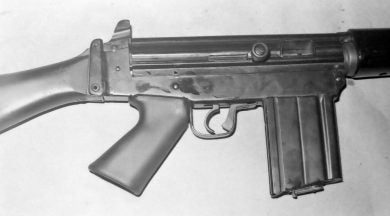

Closer up views of one of the “Falbina” prototypes, with the floor plate of the small 20-round magazine protruding slightly from the false, non-removable FAL magazine, and the Garand-type safety within the trigger guard. The bottom picture also shows the small fire selector intended for use by instructors.
A particularly unusual feature was an additional safety switch on the left side of the receiver, intended to be used by the instructor: one of the positions locked the firing mechanism after each shot, the rifle firing again only after the instructor had set the lever accordingly, while an alternative position allowed normal semi-automatic fire. No full-auto mode, present in Brazilian Army FALs, was available.
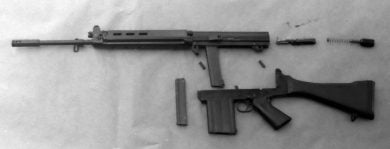
The IMBEL training rifle field-stripped. Note the small bolt and return spring for its blowback operation, as well as the .22LR magazine housing coming from the receiver.
Some prototypes with minor variations (cocking handle shape, applied safety) were completed and evaluated by Army units for possible adoption, but the program did not progress much further. Fortunately, the author was lucky enough to have had chances to fire the unofficially called “Falbina” (a mix of FAL and Carabina, or Carbine) at the Factory back in 1982 and 1983.

The 20-round .22LR magazine being inserted into the false, fixed FAL magazine. A closer look at the photo will show that this example of the IMBEL training rifle, like the one in the previous picture, is not fitted with the Garand-style trigger safety, and that the charging handle on the left side of the receiver (right side, in the original rifle) is of the fold-flat type.
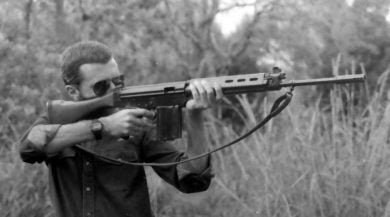
Author having fun with a “Falbina” at Fábrica de Itajubá back in the early 1980s.
The Brasarms rimfire conversion kit

Components of the kit (top to bottom): barrel insert, skeleton bolt assembly, safety sear releaser and two magazines.
The same idea of using a .22LR-chambered weapon to give recruits initial instruction on the FAL handling and firing procedures again emerged in Brazil in 1985-86 when a Rio de Janeiro-based company, Brasarms Indústria e Comércio Ltda, created a clever conversion kit to do that. The contraption was the brainchild of Olympio Vieira de Mello Filho, the father of the 9x19mm Uru submachine gun (I intend to post an article on that controversial SMG in the near future). Following its submission to official Brazilian Army certification testing at the Campo de Provas da Marambaia (Marambaia Proving Grounds), which included a successful 5,000-round accuracy, reliability and resistance test program, I was also able to lay my hands on it for a personal assessment.


Top view of the lightweight bolt structure shows the firing pin with its spring, as well as the return spring/guide rod support structure at the rear. The safety sear mechanism was released by a blow of the disconnector (bottom) attached to bolt as it moved home forward, thus freeing the hammer to fire. Bottom picture: the bolt face.
The Brasarms kit consisted of a barrel insert (540mm long, 6 grooves, RH twist), bolt assembly and two magazines. Assembly was remarkably straightforward, not taking one (myself included) much more than one minute, after a couple of oriented attempts. Open the FAL by rotating the take-down lever anti-clockwise and swinging the buttstock down. Remove the receiver cover, subsequently withdrawing the entire bolt and gas operating assembly (bolt, bolt carrier, recoil spring and its guide rod). Insert the reduced barrel all the way into the rifle’s, which was recommended to have been lightly lubricated beforehand. Attach the safety sear disconnector to the bolt unit, and slide this assembly into the receiver. Put the receiver cover back on the gun, and close the rifle again.

Installing the kit in a solid stock FAL: (1) .22LR barrel ready to be inserted into 7.62x51mm barrel; (2) insert going all the way into FAL’s barrel; (3) safety sear release (top) is attached to left side of skeleton bolt; (4) bolt assembly with the disconnector in place; (5) bolt assembly being inserted into rear end of receiver; (6) bolt assembly in place within the receiver; (7) receiver cover being slid back to the gun, which could then be closed again.
Rather than using an insert for the standard FAL magazine, the Brazilian kit was supplied with two factory-modified units. An exact replica of the original magazine, the training unit also duplicated the 20-round capacity and was adequately ballasted to give the very same weight loaded with .22LR ammo as if it had equal number of 7.62x51mm rounds: 750 grams. Hand-filling the single-row magazines got a little difficult (at least, in the examples at hand) after the 15th cartridge or so. The ejector was integral with the magazine.
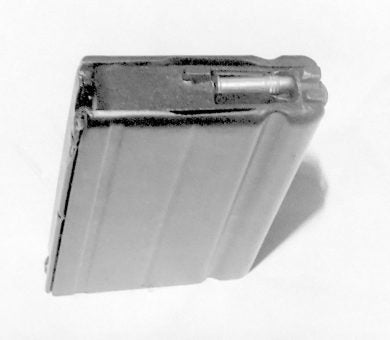
This view of the kit’s magazine clearly shows a tiny .22LR cartridge at feed lip. Twenty-round capacity duplicated that of the 7.62x51mm original.
With the kit fully installed, the rifle obviously became blowback-operated. To compensate for the different ammunition ballistic characteristics, the FAL rear sight should be adjusted at the 400-600 meter range in the standard sliding model, or at 250 meters in the Para-FAL flip aperture, where accuracy could be mastered to a very fine degree. By using reduced-scale (1/5th or 1/10th) bullseye or tactical targets, long range engagements could be effectively simulated at distances as short as, say, 10 or 20 meters, so indoor training facilities could be easily and economically set up.
As it should be expected, a 5kg rifle firing tiny .22LR cartridges was rock-steady all through. With no kicks on your shoulder and no muzzle blast to worry about, you could concentrate on… just hitting targets. We (myself and son/photographer Alexander) shot mainly at 1/10th reduced tactical targets, which roughly corresponded to firing at man-sized targets at 100-200 meters. Accuracy was excellent, and apart from one or another flier, kill-zone hits were the rule for off-the-shoulder firing. With the rifle lightly supported, we could even “play sniper” and started hitting “heads only”. Considering that the FAL’s battle iron sights are not that good for precision shooting, results were more than satisfactory.
The converted rifles also shot very well at full-auto, cyclic rates of fire being in the region of 700 rounds per minute. Since the lack of recoil and muzzle climb were not representative of the real-deal 7.62x51mm FAL, the rock-and-roll practice should not be considered really instructional, but it gave us a lot of fun!


Alexander Olive firing a converted Para-FAL at full auto from the hip and (bottom photo) dad doing the same, stock folded. The full-caliber rifle would be all but uncontrollable in this case.
And there was one particular working difference between original and modified rifles: the .22LR’s bolt remained closed after the last round was fired, while in the 7.62x51mm FAL there is a pin (mounted in the receiver to the right of the ejector) to hold the bolt in the rear position when the magazine is empty. Duplicating the different magazine components responsible for that proved unnecessarily complicated, so the Brasarms company dropped the feature. Unfortunately, local and overseas interest in a rimfire-converted FAL was not as great as anticipated. So…
 Your Privacy Choices
Your Privacy Choices
